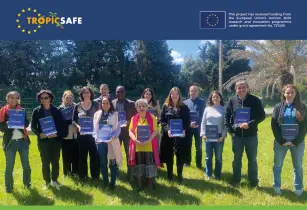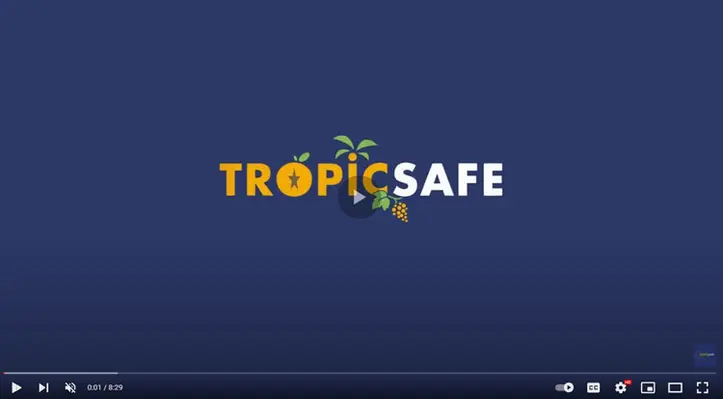The TROPICSAFE project, funded by the European Union’s Horizon 2020 research and innovation programme and coordinated by Professor Assunta Bertaccini, University of Bologna, Italy, studied three economically important insect-borne prokaryote-associated diseases of perennial crops grown in tropical and subtropical areas
Diverse ‘Candidatus Phytoplasma’ species associated with lethal yellowing in coconut palms and yellows in grapevine, and ‘Ca. Liberibacter’ species associated with “huanglongbing” in citrus, were detected and studied.
According to TROPICSAFE, during the last decades, these are the diseases most seriously affecting the worldwide trade and import of products and materials from these crops, because of the globalisation of trade and climate change. For their effective, efficient and sustainable management, important knowledge gaps were filled working in Africa, America and the Caribbean, as well as in Europe.
Monitoring and developing specific diagnostic methods allowed the identification of the different bacteria associated with these diseases in the various ecosystems studied. New insect vectors and alternative host plant species of the studied pathogens were also identified.
The company said that the knowledge acquired in this project will allow more specific, and environment-friendly disease management reducing the insecticide treatments. Preliminary studies carried out on the bacterial microbiome of the healthy and infected plants in the different ecosystems also open the way to innovative and specific control methodologies.
The results obtained were presented in a final conference organised over three days at the CIRAD-INRA centre in San Giuliano in Corsica. The conference recordings along with the study findings are also available on the project website and YouTube channel.
Here are some of the main findings:
Lethal yellowing of coconut palms
The project surveys in Africa resulted in the identification of ‘Ca. P. palmicola’ strains in coconut palms in Ghana and in Mozambique. In Ghana, alternative plant host species and putative insect vectors, were identified respectively. Evaluation of four dwarf coconut varieties showed that all of them have the potential to be used in rehabilitating the coconut industry in Ghana. In Cuba, Jamaica and Mexico ‘Ca. P. palmae’ was detected in coconut and other palm species, and Haplaxius crudus was confirmed as insect vector in Mexico and Cuba
Grapevine yellows
In South Africa, the ‘Ca. P. asteris’ was detected in Mesembryanthemum crystallinum, Protea cynaroides, and Raphanus sativus; it was also identified in the insects Aconurella prolixa and Exitianus sp. The most abundant insect species in vineyards was the insect vector Mgenia fuscovaria. A seasonal management plan has been developed including recommendations for leafhopper monitoring, weed control, sanitation, and chemical control. Plant-derived antimicrobial peptides were prepared and preliminary screenings against phytoplasma-containing colonies were performed. The LAMP and qPCR assays developed in the project for specific detection of the ‘Ca. P. asteris’ South African strain were tested on synthetic target DNA, DNA samples from different phytoplasmas, and on grapevine. In Italy, plants and insect samples collected in vineyards and positive for the presence of diverse grapevine phytoplasmas belonged to 16 and 12 species, respectively. The main phytoplasma diseases target for management and detection were “bois noir” and “flavescence dorée”. An experimental vineyard obtained with the F1 crossing population between genotypes with differential susceptibility to grapevine yellows was infected using insect vectors. Genotyping the individuals of the F1 population was carried out on 300 biotypes, while phenotyping is ongoing in the field. Merging the two kinds of data is helping us in the identification of the genetic traits putatively associated to grapevine yellow resistance. A new ELISA kit was developed, targeting “flavescence dorée” phytoplasmas. To assess the analytical performances of the developed serological detection protocol for phytoplasmas, a comparative analysis of the ELISA versus qPCR was carried out using grapevine, other plant and insect samples, and gave good results. Antisera produced using phytoplasma colonies of ‘Ca. P. asteris’ were tested by the immunoflourescence assay (IFAS) and were able to detect the agent in colonies containing the phytoplasma and in periwinkle phytoplasma infected samples.
Citrus ‘huanglongbing’ disease
Surveys in citrus orchards confirmed the presence of ‘Ca. L. africanus’ in South Africa and ‘Ca. L. asiaticus’ in Guadeloupe, Jamaica, Mexico and Cuba, but none of these bacteria was detected in the surveys carried out in five citrus-growing regions of Chile and in Spain. Surveys did not result in the detection of alternative insect or plant host species. The presence of the known vectors Diaphorina citri in Cuba, Mexico, and Guadeloupe, and Trioza erytreae in South Africa and in Spain was confirmed. Since native parasitoids of T. erytreae were not identified in Spain, Tamarixia dryi from South Africa was introduced and showed good dispersion and parasitism efficacy in the Canary Islands first, and in Spain later. The seasonal trend of T. erytreae determined in the Canary Islands indicated between four and five generations per year, but its population remained very low after the summer.









